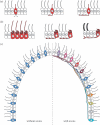Origin and early evolution of neural circuits for the control of ciliary locomotion
- PMID: 21123265
- PMCID: PMC3049052
- DOI: 10.1098/rspb.2010.2027
Origin and early evolution of neural circuits for the control of ciliary locomotion
Abstract
Behaviour evolved before nervous systems. Various single-celled eukaryotes (protists) and the ciliated larvae of sponges devoid of neurons can display sophisticated behaviours, including phototaxis, gravitaxis or chemotaxis. In single-celled eukaryotes, sensory inputs directly influence the motor behaviour of the cell. In swimming sponge larvae, sensory cells influence the activity of cilia on the same cell, thereby steering the multicellular larva. In these organisms, the efficiency of sensory-to-motor transformation (defined as the ratio of sensory cells to total cell number) is low. With the advent of neurons, signal amplification and fast, long-range communication between sensory and motor cells became possible. This may have first occurred in a ciliated swimming stage of the first eumetazoans. The first axons may have had en passant synaptic contacts to several ciliated cells to improve the efficiency of sensory-to-motor transformation, thereby allowing a reduction in the number of sensory cells tuned for the same input. This could have allowed the diversification of sensory modalities and of the behavioural repertoire. I propose that the first nervous systems consisted of combined sensory-motor neurons, directly translating sensory input into motor output on locomotor ciliated cells and steering muscle cells. Neuronal circuitry with low levels of integration has been retained in cnidarians and in the ciliated larvae of some marine invertebrates. This parallel processing stage could have been the starting point for the evolution of more integrated circuits performing the first complex computations such as persistence or coincidence detection. The sensory-motor nervous systems of cnidarians and ciliated larvae of diverse phyla show that brains, like all biological structures, are not irreducibly complex.
Figures




References
-
- Srivastava M., et al. 2010. The Amphimedon queenslandica genome and the evolution of animal complexity. Nature 466, 720–72610.1038/nature09201 (doi:10.1038/nature09201) - DOI - DOI - PMC - PubMed
-
- Tessmar-Raible K. 2007. The evolution of neurosecretory centers in bilaterian forebrains: insights from protostomes. Semin. Cell Dev. Biol. 18, 492–501 - PubMed
-
- Philippe H., et al. 2009. Phylogenomics revives traditional views on deep animal relationships. Curr. Biol. 19, 706–71210.1016/j.cub.2009.02.052 (doi:10.1016/j.cub.2009.02.052) - DOI - DOI - PubMed
-
- Dunn C. W., et al. 2008. Broad phylogenomic sampling improves resolution of the animal tree of life. Nature 452, 745–74910.1038/nature06614 (doi:10.1038/nature06614) - DOI - DOI - PubMed
-
- Degnan S. M., Degnan B. M. 2006. The origin of the pelagobenthic metazoan life cycle: what's sex got to do with it? Integr. Comp. Biol. 46, 683–69010.1093/icb/icl028 (doi:10.1093/icb/icl028) - DOI - DOI - PubMed
Publication types
MeSH terms
LinkOut - more resources
Full Text Sources
Other Literature Sources
Research Materials
